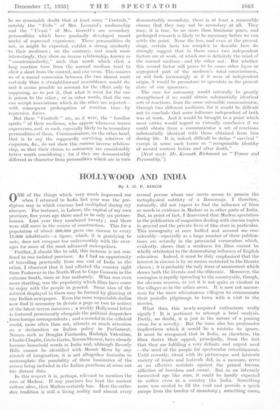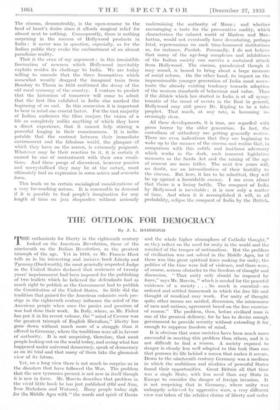HOLLYWOOD AND INDIA
By I. G. P. SINGH ONE' of the things which very much impressed me when I returned to India last year was the pro- digious way in which cinemas had multiplied during my absence. For instance, in Lahore, the Capital of my own provinde, live years ago there used to be only six picture- houses. " Last year they numbered twenty ; and there were still More in the course of construction. This for a population of about 300,000 gives one cinema to every 15;000 inhabitants-a figure, which, it is gratifying to note, does not compare too unfavourably with the aver- ages for some of the most advanced metropolises. Furtherio.I should like to add, this increase is not con- fined tO One isolated province: As I had an opportunity travelling practically from one end of India to the other, I observed that it had affected the country right from Peshawar in the North-West to Cape Corner in in the extreme South, more or less uniformly. What was even more startling; was the popularity which films have come to -enjciy. with the people in general. Some idea of the interest displayed in them may be formed by glancing at any Indian newspaper. Even the more respectable dailies now find it necessary to devote a page or twO to notices of the latest screen successes ; a weekly Hollywood letter is featured prominently alongside the political despatches from foreign correspondents ; and a scandal in the celluloid world, more .often than not, attracts as much attention as a declaration on Indian policy in Parliament. Names- •such as Douglas Fairbanks, Rudolph' Valentine, Charlie Chaplin, Greta Garbo, Norma Shearer, have already become household words in India and, although Beverly Hills cannot be identified with Mount Meru by any stretch of imagination, it is not altogether fantastic to contemplate the possibility of these luminaries of the screen being included in the Indian pantheon at some not too distant date.
In this respect it is, perhaps, relevant to mention the case of Madras. If any province has kept the ancient culture alive then Madras certainly has.- Here the ortho- dox tradition is still a living reality and almost every second person whom one meets seems to possess the metaphysical subtlety of a Ramanuja. I therefore, naturally, did not expect to find the influence of films so much in evidence in Madras as in other parts of India. But, in point of fact,. I discovered that Madras specialises in the publication of magazines dealing with cinema topics in general and the private lives of film stars in particular. This incongruity at once baffled and amused me con- siderably—especially as a large number of these publications are actually in the provincial vernaculars which, evidently, shows that a weakness for films cannot be wholly attributed to the demoralising influence of English education. Indeed, it must be duly emphasised that the interest in cinema is by no means restricted to the literate classes ; it is probably the only form of amusement which draws both the literate and the 'illiterate. Moreover, the contagion is rapidly spreading to the countryside, though, for obvious reasons, as yet it is not quite so 'virulent in the villages as in the urban areas. It is now not uncom- mon for the more adventurous villagers to consummate their periodic pilgrimage to town with a visit to the movies, What does this newly-acquired enthusiasm really signify ? It is pertinent to attempt a brief analysis. Partly, no doubt, it is just in the nature of a passing craze for a novelty. But the issue also has profounder implications which it would be a mistake to ignore. It must be recognised that in India, as elsewhere, the films derive their appeal, principally, from. the fact that they are fulfilling a very definite and urgent need —the need of the people for spectacular entertainment. Until recently, ritual with its picturesque and intricate variety of feasts. and festivals did, in a measure, serve as an effective 'antidote against the primal human affliction of boredom and ennui. But in an intensely tormented age like ours, it could be hardly expected to suffice even in 'a country like India. Something more was needed to fill the void and provide a quick escape from the burden of monotony ; something came. The cinema, demonstrably, is the open-sesame to the land of heart's desire since it affords magical relief for almost next to nothing. Consequently, there is nothing surprising in the success of Hollywood products in India : it never was in question, especially, as for the Indian public they evoke the enchantment of an almost paradisiac reality.
That is the crux of my argument : in this irresistible fascination of newness which Hollywood inevitably exploits resides its challenge to India. We are today willing to concede that the three locomotives which somewhat wearily dragged the inaugural train from Bombay to Thana in 1853 confirmed the decay of the old rural economy of the country. I venture to predict that the historians of tomorrow will come to admit that the first film exhibited in India also marked the beginning of an end. In this connexion it is important to bear in mind one crucial factor. For the vast majority of Indian audiences the films conjure the vision of a life so completely unlike anything of which they have a direct experience, that it cannot help stirring a powerful longing in their consciousness. It is indis- putable that the contrast between their immediate environment and the fabulous world, the glimpses of which they have on the screen, is extremely poignant. Whatever may be their reaction to it, it is certain it cannot be one of contentment with their own condi- tions. And these pangs of discontent, however passive and unerystallised they may be at the outset, must ultimately find an expression in some active and concrete form.
This leads us to certain sociological considerations of a very far-reaching nature. It is reasonable to demand if it is possible to feed people's imagination for any length of time on jazz rhapsodies without seriously undermining the authority of Manu ; and whether encouraging a taste for the provocative nudity, which characterises the cabaret world of Harlem and Man- hattan, would not eventually have devastating, perhaps fatal, repercussions on such time-honoured institutions as, for instance, Purdah. Personally, I do not believe that many of the age-long complexes and inhibitions of the Indian society can survive a sustained attack from Hollywood: The cinema, paradoxical though it may sound, is bound to bring about a large measure of social reform. On the other hand, its impact on the impressionable younger generation of India must accen- tuate the already existing tendency towards adoption of the western standards of behaviour and value. Thus if the WM& which has started in India is at all symp- tomatic of the trend of events in the East in general, Hollywood may still prove Mr. Kipling to be a false prophet. That much, at any rate, is becoming in- creasingly clear.
All these developments, it is true, are regarded with pious horror by the older generation. In fact, the custodians of orthodoxy are getting generally restive. There are even indications that they are beginning to wake up to the menace of the cinema and realise that, in comparison with this subtle and insidious adversary' which works in the dark, such innocent legislative measures as the Sarda Act and the raising of the age of consent are mere trifles. The next few years will; no doubt, see an intensification of their hostility to the cinema. But here, it has to be admitted, they will be up against a formidable enemy. I am even afraid that theirs is a losing battle. The conquest of India by Hollywood is inevitable : it is now only a matter of time. And when it is accomplished it will, in all probability, eclipse the conquest of India by the British.



































 Previous page
Previous page